
The Asmara-Massawa Cableway was a cableway (or "ropeway") built in Italian Eritrea before World War II. [1] The Eritrean Ropeway, completed in 1937, ran 71.8 km from the south end of Asmara to the city-port of Massawa. [2]

The Asmara-Massawa Cableway was a cableway (or "ropeway") built in Italian Eritrea before World War II. [1] The Eritrean Ropeway, completed in 1937, ran 71.8 km from the south end of Asmara to the city-port of Massawa. [2]

The cableway was built by the Italian engineering firm Ceretti and Tanfani S.A. in Eritrea. It connected the port of Massawa with the city of Italian Asmara [3] and ran a distance of nearly 72 kilometres. It also moved food, supplies and war materials for the Imperial Italian Army, which had also conquered Ethiopia in 1936. In August 1936 the first section of 26.6 km was opened from Ghinda to Godaif, a suburb of Asmara.
The Eritrean Ropeway, completed in 1937, ran 71.8 km from near Massawa to the south end of Asmara. This was the longest cableway ever. It covered a distance which was over twice the current one longest in the world which has less than 35 km in Lapland. It was rendered non-operational by the British removing the engines shortly after their victory at Keren [1941] in World War II. The assemblage stood for over twenty years and was still in very good condition in 1962. Ralph Reinhold
With the capacity to transport 30 tons of material every hour in each direction from the seaport of Massawa to 2326 meters above sea level in Asmara, the cableway was the longest of its kind in the world when inaugurated in 1937. The bearing cables were in almost 30 sections, were powered by diesel engines, and carried freight in 1540 small transport gondolas. In southern Eritrea there was another small ropeway. [4]
The Massawa-Asmara cableway is now recognized as the longest three-cable aerial line ever constructed. For a brief overview of the gigantic work, it is enough to outline the following facts: 1) The mechanical components reach a weight of a little less than a thousand tons; the cables weigh the same; and the aggregate weight of the structural steel work amounts to almost two thousand tons; 2) The walls and foundations amount to 15,000 cubic meters of concrete; 3) The earthworks and the pits for the foundations required the excavation of 45,000 cubic meters, of which about 35,000 were solid rock. Il Chichingiolo
During their eleven-year military administration (1941-1952) of the former Italian colony, the British dismantled the installations. They removed the diesel engines, the steel cables, and other equipment as war reparations. Iron towers that remained were scrapped in the 1980s.
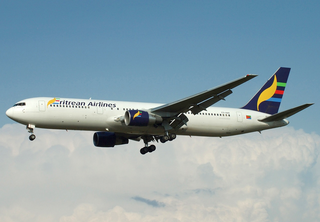
Transport in Eritrea includes highways, airports and seaports, in addition to various forms of public and private vehicular, maritime and aerial transportation.

An aerial tramway, aerial tram, sky tram, aerial cablecar, aerial cableway, telepherique, or seilbahn is a type of aerial lift which uses one or two stationary ropes for support while a third moving rope provides propulsion. With this form of lift, the grip of an aerial tramway cabin is fixed onto the propulsion rope and cannot be decoupled from it during operations. In comparison to gondola lifts, aerial tramways generally provide lower line capacities and longer wait times.

A gondola lift is a means of cable transport and type of aerial lift which is supported and propelled by cables from above. It consists of a loop of steel wire rope that is strung between two stations, sometimes over intermediate supporting towers. The cable is driven by a bullwheel in a terminal, which is typically connected to an engine or electric motor. It is often considered a continuous system since it features a haul rope which continuously moves and circulates around two terminal stations. In contrast, an aerial tramway operates solely with fixed grips and simply shuttles back and forth between two end terminals.
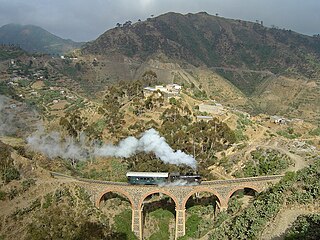
The Eritrean Railway is the only railway system in Eritrea. It was constructed between 1887 and 1932 during the Italian Eritrea colony and connects the port of Massawa with Asmara. Originally it also connected to Bishia. The line was partly damaged by warfare in subsequent decades, but was rebuilt in the 1990s. Vintage equipment is still used on the line.

Massawa or Mitsiwa is a port city in the Northern Red Sea region of Eritrea, located on the Red Sea at the northern end of the Gulf of Zula beside the Dahlak Archipelago. It has been a historically important port for many centuries. Massawa has been ruled or occupied by a succession of polities during its history, including the Kingdom of Aksum, the Ethiopian Empire, the Ottoman Empire and the Kingdom of Italy.

A material ropeway, ropeway conveyor is a subtype of gondola lift, from which containers for goods rather than passenger cars are suspended.

Norsjö aerial tramway is a 13.2 kilometre long aerial tramway between Örträsk and Mensträsk in the Norsjö Municipality in Sweden.
Articles related to Eritrea include:

The Leone class were a group of destroyers built for the Italian Navy in the early 1920s. Five ships were planned and three completed. All three ships were based at Massawa, Eritrea, during World War II and were sunk during the East African Campaign.

Italian Eritreans are Eritrean-born citizens who are fully or partially of Italian descent, whose ancestors were Italians who emigrated to Eritrea during the Italian diaspora, or Italian-born people in Eritrea.
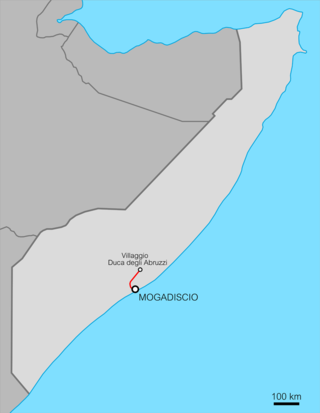
The Mogadiscio–Villabruzzi Railway is an historical railway system that ran through southern Somalia. It was constructed between 1914 and 1927 by the colonial authorities in Italian Somaliland. The railway connected the capital city Mogadishu with Afgooye, and subsequently with Villaggio Duca degli Abruzzi – usually called "Villabruzzi". The line was later dismantled by British troops during World War II. Plans for re-establishing the railway were made in the 1980s by the Siad Barre administration, but were aborted after the regime's collapse.

Italian Eritrea was a colony of the Kingdom of Italy in the territory of present-day Eritrea. The first Italian establishment in the area was the purchase of Assab by the Rubattino Shipping Company in 1869, which came under government control in 1882. Occupation of Massawa in 1885 and the subsequent expansion of territory would gradually engulf the region and in 1889 the Ethiopian Empire recognized the Italian possession in the Treaty of Wuchale. In 1890 the Colony of Eritrea was officially founded.
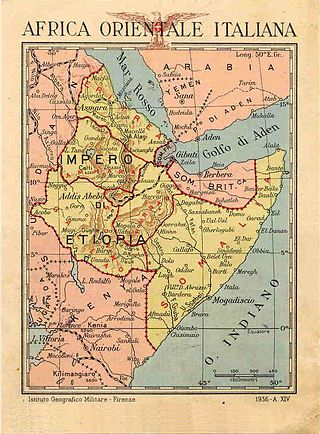
Eritrea Governorate was one of the six governorates of Italian East Africa. Its capital was Asmara. It was formed from the previously separate colony of Italian Eritrea, which was enlarged with parts of the conquered Ethiopian Empire following the Second Italo-Ethiopian War.
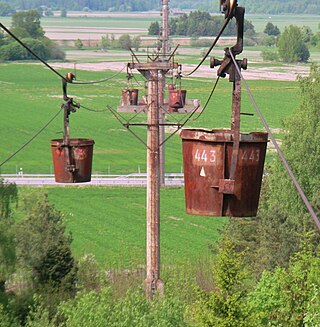
The Forsby-Köping limestone cableway, commonly referred to in Swedish as Kalklinbanan, was a 42 km aerial tramway running from Forsby in Vingåker municipality to industrial town Köping in central Sweden. Its final destination is the factory at the port of Köping, where cement was manufactured until 1978, and later various limestone derivatives. The cableway was Europe's longest at the time of construction. It was later superseded by a handful of longer cableways, notably the Norsjö aerial tramway, all of which were demolished during the 1960s–1980s. It was taken out of service in 1997 but kept in working order. By that time all longer industrial cableways had been demolished making it at present the world's longest cableway in working order.

The Italian colonial railways started with the opening in 1888 of a short section of line in Italian Eritrea, and ended in 1943 with the loss of Italian Libya after the Allied offensive in North Africa and the destruction of the railways around Italian Tripoli. The colonial railways of the Kingdom of Italy reached 1,561 kilometres (970 mi) before WWII.

Italian submarine Macallé was an Adua-class submarine built for the Royal Italian Navy during the 1930s. It was named after a town of Mek'ele in Ethiopia.
The following is a timeline of the history of the city of Asmara, Eritrea. Asmara was under Italian colonial rule from 1889 until 1941.

The Imperial Line was a flight route of the Italian national airline Ala Littoria between 1935 and 1941 during the Fascist era. It was the longest route in the Italian colonial empire in Africa and "the jewel in Ala Littoria's crown". It connected Rome with Benghazi (Libya), Asmara (Eritrea), Addis Abeba (Ethiopia) and Mogadishu (Somalia). It carried passengers and mail. Italy ultimately lost control of the route during World War II.